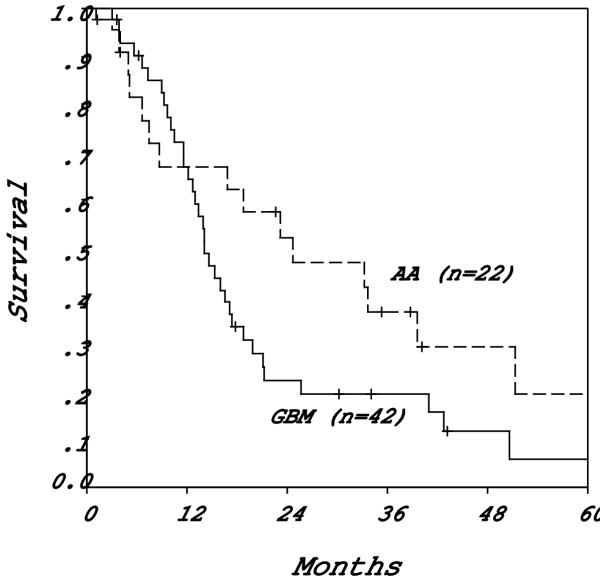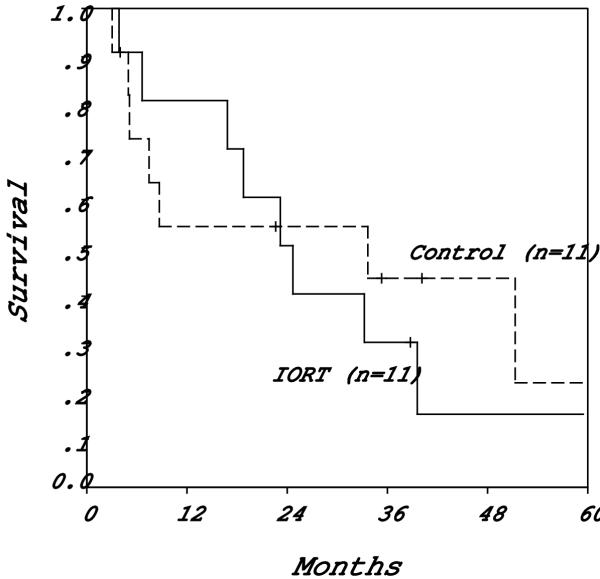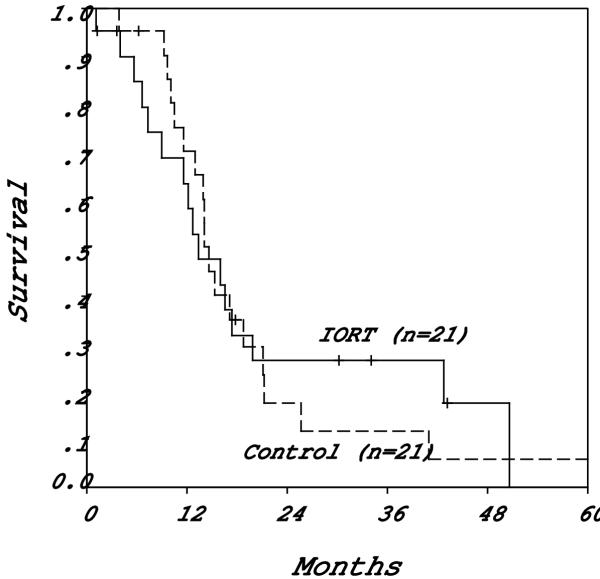Abstract
Background
Intraoperative radiation therapy (IORT) is one of the methods used to deliver a large single dose to the tumor tissue while reducing the exposure of normal surrounding tissue. However, the usefulness of intraoperative electron therapy for malignant gliomas has not been established.
Methods
During the period from 1987 to 1997, 32 patients with malignant gliomas were treated with IORT. The histological diagnoses were anaplastic astrocytoma in 11 patients and glioblastoma in 21 patients. Therapy consisted of surgical resection and intraoperative electron therapy using a dose of 12–15 Gy (median, 15 Gy). The patients later underwent postoperative external radiation therapy (EXRT) with a median total dose of 60 Gy. Each of the 32 patients treated with IORT was randomly matched with patients who had been treated with postoperative EXRT alone (control). Patients were matched according to histological grade, age, extent of tumor removal, and tumor location.
Results
In the anaplastic astrocytoma group, the one-, two- and five-year survival rates were 81%, 51% and 15%, respectively in the IORT patients and 54%, 43% and 21%, respectively in the control patients. In the glioblastoma group, one-, two- and five-year survival rates were 63%, 26% and 0%, respectively in the IORT patients and 70%, 18% and 6%, respectively in the control patients. There was no significant difference between survival rates in the IORT patients and control patients in either the anaplastic astrocytoma group or glioblastoma group.
Conclusions
IORT dose not improve survival of patients with malignant gliomas compared to that of patients who have received EXRT alone.
Backgroud
Surgery and radiotherapy have been used to treat malignant gliomas for many years, but the prognosis of malignant glioma patients has been remained unsatisfactory. Since local recurrence rather than distant metastasis is the main pattern of recurrence [1-3], improvement in the local control rate may greatly improve the survival of patients with malignant gliomas. Increasing the total radiation dose is one possible way of improving local control. However, damage to the normal brain tissue increases with increase in total radiation dose [4].
Intraoperative radiation therapy (IORT) is one of the methods used for delivering a large single dose to the tumor tissue while reducing the exposure of normal surrounding tissue. However, the usefulness of IORT for malignant gliomas has not been established. In this retrospective case-control study, the results of treatment with IORT and external radiation therapy (EXRT) for previously untreated malignant glioma patients were compared with those EXRT alone.
Methods
From 1987 through 1997, 32 patients with previously untreated malignant gliomas were treated with IORT. Histological diagnoses were anaplastic astrocytoma (AA) in 11 patients and glioblastoma (GBM) in 21 patients. The decision to use IORT was made by neurosurgeons and radiation oncologists. IORT was not used for patients with deep-seated tumors or infra-tentorial tumors. Moreover, since there were only two linear accelerators in our hospital during the period 1982 to 1998, the use of a linear accelerator for IORT was severely restricted and only a limited number of patients could be treated with IORT. Following as much tumor removal as possible, patients were transferred from the operating room to the linac room. Then cones of 4–8 cm in diameter attached to the linac gantry were placed directly onto the tumor bed. The energy of the electron beams ranged from 4 to 15 MeV depending on the estimated tumor depth. The IORT dose ranged from 12 to 15 Gy (median, 15 Gy; mean, 14.9 Gy). The IORT dose was evaluated at the peak point.
Following IORT, all patients EXRT at a median total dose of 60 Gy (mean dose, 57 Gy; range, 17–72 Gy). A 10 MV X-ray generated by a linear accelerator was used for EXRT. The clinical target volume was gross tumor (determined by CT or MRI images postoperatively) with a 2-cm margin. The median time interval from IORT and start of EXRT was 15 days (range, 9–41 days). Written informed consent was obtained from all of the eligible patients. Each of the 32 patients treated with IORT was randomly matched with a malignant glioma patient treated with EXRT alone from 1982 to 1997 (number of patients, 236). Patients were matched according to histological grade (AA or GBM), age (=<59 years old or >59 years old), extent of tumor removal (total removal, subtotal removal or partial removal, biopsy only), and tumor location. However, performance status could not be used as a matching criterion in many of the patients due to lack of clinical information. The patients' characteristics are listed in Table 1: The treatment characteristics are listed in Table 2.
The length of survival was measured from the time of surgery until the patients died or until the time of final analysis. The last follow up examination was performed in October 2000. The Kaplan-Meier method was used to calculate the survival rate. The differences between survival curves were evaluated by the logrank test.
Results
The median survival times for AA patients and GBM patients were 24.7 months and 14.1 months, respectively. The one-, two- and five-year survival rates in AA patients were 67%, 52% and 19%, respectively, and those in GBM patients were 67%, 22% and 6%, respectively (Fig. 1). The difference between survival rates of AA patients and GBM patients was statistically significant (p = 0.046).
Figure 1.
Survival curves by histological diagnosis.
In the AA group, the median survival times in IORT patients and control patients were 24.7 months and 33.6 months, respectively. The one, two, and five-year survival rates in IORT patients were 81%, 51% and 15%, respectively, and those in control patients were 54%, 43% and 21%, respectively. There was no significant difference between survival rates in the treatment groups (Fig. 2).
Figure 2.
Survival of patients with anaplastic astrocytoma by use of IORT.
In the GBM group, the median survival time in IORT patients was 13.3 months and that in control patients was 14.6 months. The one-, two- and five-year survival rates in IORT patients were 63%, 26% and 0%, respectively, and those in control patients were and 70%, 18% and 6%, respectively. The survival rate from 24 to 48 months was better in IORT patients than in control patients, but the difference was not statistically significant. The only patient who survived more than five years was in the control group (Fig. 3).
Figure 3.
Survival of patients with glioblastoma by use of IORT.
There were no treatment-related deaths in the patients who received IORT and in those who did not. In four IORT patients and in one control patient, CT and MRI findings suggested brain necrosis. However, differential diagnosis of brain necrosis from tumor regrowth was difficult in these patients.
Discussion
Increasing the total radiation dose is the possible way to improve the local control of malignant gliomas. A study by Walker et al showed beneficial effect of dose escalation up to 60 Gy [5]. On the other hand, Chang et al. reported that there was no advantage of a radiation dose of 70 Gy for 8–9 weeks over a dose of 60 Gy for 6–7 weeks [6]. Therefore, the standard radiation dose used for malignant gliomas has been 60 Gy/6–7 weeks, and the usefulness of dose escalation over 60 Gy for malignant glioma has been controversial. On the other hand, since recurrences occur from the initial tumor regions in most malignant gliomas patients, attempts have been made to deliver a large dose to the tumors while avoiding surrounding normal tissue using IORT [7-9], brachytherapy [10,11], conformal radiation therapy [12], particle radiation therapy [13], and radiosurgery [14].
Several authors reported that IORT improved survival of malignant glioma patients. Matsutani et al. treated 30 glioblastoma patients with IORT (mean dose,18.3 Gy) combined with EXRT (mean dose, 58.5 Gy), and the median survival period and 2-year survival rate were 119 weeks and 61%, respectively, in their series [9]. Ortiz et al. used IORT for malignant glioma patients and reported that the overall 1-year survival rates were 67% for AA patients and 56% for GBM patients [8]. Fujiwara et al. used IORT with EXRT for 20 previously untreated malignant glioma patients. They reported that the survival of patients who had undergone IORT was better than that of patients who had been treated with EXRT alone. The median survival periods were 14 months for the patients who had been treated with IORT and 10 months for the patients who had been treated with EXRT alone [7].
However, we must be careful when comparing the results of treatment with IORT with the results in controls, because IORT can not be used for patients with deep-seated tumors, multifocal tumors, diffuse infiltrating tumors, very large tumors, or infra-tentorial tumors. Therefore, it is possible that the selection criteria of patients for IORT greatly influence the treatment outcomes. In this study, a matched-pair group of patients who had been treated with EXRT alone was used for the control group to minimize confounding. As a result, there was no significant difference between survival rates of either AA or GBM patients who had received IORT and those who had not.
In our series, the settings of cones in the linac room were made by neurosurgeons and radiation oncologists, depending on the findings at tumor removal. However, it was difficult to determine the optimal position and direction of the cones in the linac room, because radiotherapy planning based on CT and MRI images was impossible in such situations. Therefore, the method of cone and patient setting in the linac room might have resulted in geographic errors and might have influenced the treatment outcomes. In order to correct such possible setting errors, intraoperative CT-based planning with a mobile CT and a fixation device that is used for radiosurgery may be useful. The usefulness of IORT should be tested again in a randomized clinical trial after the establishment of radiotherapy planning methods for IORT and a method to reproduce the planned setting in the linac room.
Conclusions
IORT did not improve survival of malignant glioma patients compared to that of following conventional radiation therapy alone.
Table 1.
Patients characteristics.
| IORT | Control | |
| Age (years old) | ||
| median | 59 | 59 |
| range | 24–72 | 27–73 |
| Sex | ||
| male | 22 | 22 |
| female | 10 | 10 |
| Histology | ||
| AA | 11 | 11 |
| GBM | 21 | 21 |
| Tumor site | ||
| frontal | 12 | 12 |
| temporal | 13 | 13 |
| parietal | 4 | 4 |
| occipital | 3 | 3 |
| Performance status (WHO) | ||
| 0 | 1 | 3 |
| 1 | 2 | 0 |
| 2 | 6 | 5 |
| 3 | 8 | 11 |
| 4 | 3 | 2 |
| unknown | 12 | 11 |
IORT = Intraoperative radiation therapy AA = Anaplastic astrocytoma GBM = Glioblastoma
Table 2.
Treatment characteristics.
| IORT | Control | |
| EXRT dose (Gy) | ||
| median | 60 | 60 |
| range | 18–72 | 30–84 |
| IORT dose (Gy) | ||
| median | 15 | - |
| range | 12–15 | - |
| IORT energy (MeV) | ||
| 4 | 1 | - |
| 6 | 9 | - |
| 8 | 13 | - |
| 10 | 5 | - |
| 12 | 2 | - |
| 15 | 2 | - |
| Cone diameter (cm) | ||
| 3 | 1 | - |
| 4 | 10 | - |
| 5 | 1 | - |
| 6 | 17 | - |
| 8 | 3 | - |
EXRT = External beam radiation therapy IORT = Intraoperative radiation therapy
Pre-publication history
The pre-publication history for this paper can be accessed here:
Contributor Information
Kenji Nemoto, Email: knemoto@rad.med.tohoku.ac.jp.
Yoshihiro Ogawa, Email: ogaway@rad.med.tohoku.ac.jp.
Haruo Matsushita, Email: peropero@hosp.tohoku.ac.jp.
Ken Takeda, Email: takedara@rad.med.tohoku.ac.jp.
Yoshihiro Takai, Email: y-takai@rad.med.tohoku.ac.jp.
Shogo Yamada, Email: yamada@rad.med.tohoku.ac.jp.
Toshihiro Kumabe, Email: kuma@nsg.med.tohoku.ac.jp.
References
- Choucair AK, Levin VA, Gutin PH, Davis RL, Silver P, Edward MSB, Wilson CB. Development of multiple lesions during radiation therapy and chemotherapy in patients with gliomas. J Neurosurg. 1986;65:654–658. doi: 10.3171/jns.1986.65.5.0654. [DOI] [PubMed] [Google Scholar]
- Hochberg FH, Pruitt A. Assumptions in the radiotherapy of glioblastoma. Neurology. 1980;30:907–911. doi: 10.1212/wnl.30.9.907. [DOI] [PubMed] [Google Scholar]
- Wallner KE, Galicich JH, Krol G, Malkin MG, Arbit E. Patterns of failure following treatment for glioblastoma multiforme and anaplastic astrocytoma. Int J Radiat Oncol Biol Phys. 1989;16:1405–1409. doi: 10.1016/0360-3016(89)90941-3. [DOI] [PubMed] [Google Scholar]
- Salazar OM, Rubin P, Feldstein ML, Pizzutiello R. High dose radiation therapy in the treatment of malignant gliomas. Final report. Int J Radiat Oncol Biol Phys. 1979;5:1733–1740. doi: 10.1016/0360-3016(79)90554-6. [DOI] [PubMed] [Google Scholar]
- Walker MD, Strike TA, Sheline GE. An analysis of dose-effect relationship in the radiotherapy of malignant gliomas. Int J Radiat Oncol Biol Phys. 1979;5:1751–1731. doi: 10.1016/0360-3016(79)90553-4. [DOI] [PubMed] [Google Scholar]
- Chang CH, Horton J, Schoenfeld D, Salazar O, Perez TR, Kramer S, Weinstein A, Nelson JS, Tsukada Y. Comparison of postoperative radiotherapy and combined postoperative radiotherapy and chemotherapy in the multidisciplinary management of malignant gliomas. A joint Radiation Therapy Oncology Group and Eastern Cooperative Oncology Group study. Int J Radiat Oncol Biol Phys. 1983;52:997–1007. doi: 10.1002/1097-0142(19830915)52:6<997::aid-cncr2820520612>3.0.co;2-2. [DOI] [PubMed] [Google Scholar]
- Fujiwara T, Honma Y, Ogawa T, Irie K, Kuyama H, Nagano S, Takahashi H, Hosokawa A, Ohkawa M, Tanabe M. Intraoperative radiotherapy for gliomas. J Neurooncol. 1995;23:81–86. doi: 10.1007/BF01058463. [DOI] [PubMed] [Google Scholar]
- Ortiz de Urbina D, Santos M, Garcia-Berrocal I, Bustos JC, Samblas J, Gutierrez-Diaz JA, Delgado JM, Donckaster G, Calvo FA. Intraoperative radiation therapy in malignant glioma: early clinical results. Neurol Res. 1995;17:289–294. doi: 10.1080/01616412.1995.11740329. [DOI] [PubMed] [Google Scholar]
- Matsutani M, Nakamura O, Nagashima T, Asai A, Fujimaki T, Tanaka H, Nakamura M, Ueki K, Tanaka Y, Matsuda T. Intra-operative radiation therapy for malignant brain tumors: rationale, method, and treatment results of cerebral glioblastomas. Acta Neurochir. 1994;131:80–90. doi: 10.1007/BF01401457. [DOI] [PubMed] [Google Scholar]
- Gutin PH, Prados MD, Phillips TL, Wara WM, Larson DA, Leibel SA, Sneed PK, Levin VA, Weaver KA, Silver P, Lamborn K, Lamb S, Ham B. External irradiation followed by an interstitial high activity iodine-125 implant "boost" in the initial treatment of malignant gliomas: NCOG study 6G-82-2. Int J Radiat Oncol Biol Phys. 1991;21:601–606. doi: 10.1016/0360-3016(91)90676-u. [DOI] [PubMed] [Google Scholar]
- Laperriere NJ, Leung PM, McKenzie S, Milosevic M, Wong S, Glen J, Pintilie M, Bernstein M. Randomized study of brachytherapy in the initial management of patients with malignant astrocytoma. Int J Radiat Oncol Biol Phys. 1998;41:1005–1011. doi: 10.1016/S0360-3016(98)00159-X. [DOI] [PubMed] [Google Scholar]
- Lee SW, Fraass BA, Marsh LH, Herbort K, Gebarski SS, Martel MK, Radany EH, Lichter AS, Sandler HM. Patterns of failure following high-dose 3-D conformal radiotherapy for high- grade astrocytomas: a quantitative dosimetric study. Int J Radiat Oncol Biol Phys. 1999;43:79–88. doi: 10.1016/S0360-3016(98)00266-1. [DOI] [PubMed] [Google Scholar]
- Fitzek MM, Thornton AF, Rabinov JD, Lev MH, Pardo FS, Munzenrider JE, Okunieff P, Bussiere M, Braun I, Hochberg FH, Hedley-Whyte ET, Liebsch NJ, Harsh GR., 4th Accelerated fractionated proton/photon irradiation to 90 cobalt gray equivalent for glioblastoma multiforme: results of a phase II prospective trial. J Neurosurg. 1999;91:251–260. doi: 10.3171/jns.1999.91.2.0251. [DOI] [PubMed] [Google Scholar]
- Gannett D, Stea B, Lulu B, Adair T, Verdi C, Hamilton A. Stereotactic radiosurgery as an adjunct to surgery and external beam radiotherapy in the treatment of patients with malignant gliomas. Int J Radiat Oncol Biol Phys. 1995;33:461–468. doi: 10.1016/0360-3016(95)00087-F. [DOI] [PubMed] [Google Scholar]





